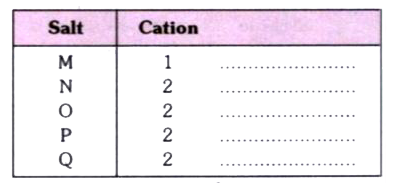(i) A salt solution gives a yellow ppt. with BaCl2 which is soluble in dil. HCL. On adding acid to the salt solution, it becomes orange in colour. Identify the acid radical.
(ii) On treating the salt with dil HCI, a colourless gas turning brown on exposure to air was evolved. On adding FeSO4, solution, the salt solution gives a brown colour Identify the acid radical present in the salt
To solve the given question, we will break it down into two parts as per the requirements.
Part (i)
1. Observation of Yellow Precipitate: The salt solution gives a yellow precipitate with BaCl2. The yellow precipitate indicates the presence of chromate ions (CrO4^2-), which form barium chromate (BaCrO4) when reacted with barium chloride.
Hint: Remember that certain metal ions form characteristic colored precipitates with specific reagents.
2. Solubility in Dilute HCl: The yellow precipitate is soluble in dilute HCl. This is consistent with the behavior of barium chromate, which dissolves in acid to form dichromate ions (Cr2O7^2-), which are orange in color.
Hint: Consider how the color of ions can change upon reaction with acids.
3. Change of Color to Orange: The addition of acid to the chromate solution converts it to dichromate, which is orange. This confirms that the anion present in the salt is indeed chromate (CrO4^2-).
Final Identification: The acid radical in the first case is Chromate (CrO4^2-).
Part (ii)
1. Colorless Gas Evolution: Treating the salt with dilute HCl produces a colorless gas that turns brown upon exposure to air. This gas is likely nitrogen monoxide (NO), which is produced from the reaction of nitride ions (NO3^-) with hydrochloric acid.
Hint: Think about the gases produced during acid-base reactions and their behavior in air.
2. Brown Color on Exposure to Air: Nitrogen monoxide (NO) reacts with oxygen in the air to form nitrogen dioxide (NO2), which is a brown gas. This confirms the presence of nitride ions in the salt.
Hint: Consider the oxidation reactions that occur when gases are exposed to air.
3. Reaction with FeSO4: When FeSO4 is added to the solution containing nitrogen monoxide, a brown ring complex is formed, which is characteristic of nitride ions. This complex is referred to as the "brown ring test".
Final Identification: The acid radical in the second case is Nitride (NO3^-).
Summary of Acid Radicals Identified:
- (i) Chromate (CrO4^2-)
- (ii) Nitride (NO3^-)
1. Observation of Yellow Precipitate: The salt solution gives a yellow precipitate with BaCl2. The yellow precipitate indicates the presence of chromate ions (CrO4^2-), which form barium chromate (BaCrO4) when reacted with barium chloride.
1. Colorless Gas Evolution: Treating the salt with dilute HCl produces a colorless gas that turns brown upon exposure to air. This gas is likely nitrogen monoxide (NO), which is produced from the reaction of nitride ions (NO3^-) with hydrochloric acid.
- (i) Chromate (CrO4^2-)
- (ii) Nitride (NO3^-)
Similar Questions
The aqueous solution of salt gives white ppt with lead acetate solution which is insoluble in hot water and nitric acid .The salt contains
View SolutionA metal salt solution gives a yellow precipitate with silver nitrate.The precipitate dissolves in dilute nitric acid as well as in dilute ammonia solution.The solution contains :
View SolutionSalt (A) is a white deliquescent solid. On heating the solid, brown fumes were evolved. On adding NaOH to the salt solution of (A), a white gelatinous ppt. was obtained. On adding, a drop of blue litmus solution to the ppt., a blue lake was obtained. On adding DPA to the salt solution, a deep blue colouration was obtained. Identify the salt and give the equations involved.
View SolutionA solid soluble in water on being heated gives brown gas and when dil. HCI is added to its aqueous solution, a white ppt is obtained. The solid is
View SolutionBaCl2 solution gives a white precipitate with a solution of a salt, which dissolves in dilute hydrochloric acid with the evolution of colourless, pungent smelling gas. The gas as well as the salt both are used as bleaching agent in the textile industries. The salt contains :
View SolutionSodium salt solution +AgNO3soln.→Coloured precipitate.
If coloured precipitate is soluble in both dil. HNO3 and excess conc. NH3 solution then which of the following anion is present in the salt solution?
View SolutionA solution of a salt in water, on addition of dilute HCI, gives a white precipitate, which is soluble in hot water. The salt contains
View SolutionSalts M, N, O, P and Q undergo reactiom (i) to (v) respectively.
Identify the cation present in these salts on the basis of these reaction. Tabulate your answer in the format given below.
1. When sodium hydroxide solution is added to the salt M, and heated strongly a colourless gas with a pungent smell is evolved which turm red litmus paper blue and gives dense white fumes with a moist glass rod with hydrochloric acid.
2. Addition of dilute hydrochloric acid to a solution of N gives a thick white precipitate which is soluble in hot water.
3. When ammonium hydroxide solution is added to the solution of 0 a light blue precipitate is obtained which is soluble in excess of ammonium hydroxide to form an inteme deep blue solution.
4. When ammonium hydroxide solution is added to the solution of P reddish brown (mustard colour) precipitate is obtained which ,is insoluble even in the excess of ammonium hydroxide solution.
5. When sodium hydroxide solution is added to the solution of Q a which coloured gelatinous precipitate is obtained which is soluble in excess of sodium hydroxide to form a clear solution

View SolutionAn original solution of an inorganic salt in dilute HCl gives a brown colouration with potassium hexacyanidoferrate (III) and reddish brown colouration with sodium acetate solution. The cation of the
salt is :
View SolutionSolution of a salt in dil H2SO4 produces deep blue colour with starch iodide solution .The salt contains
View Solution
